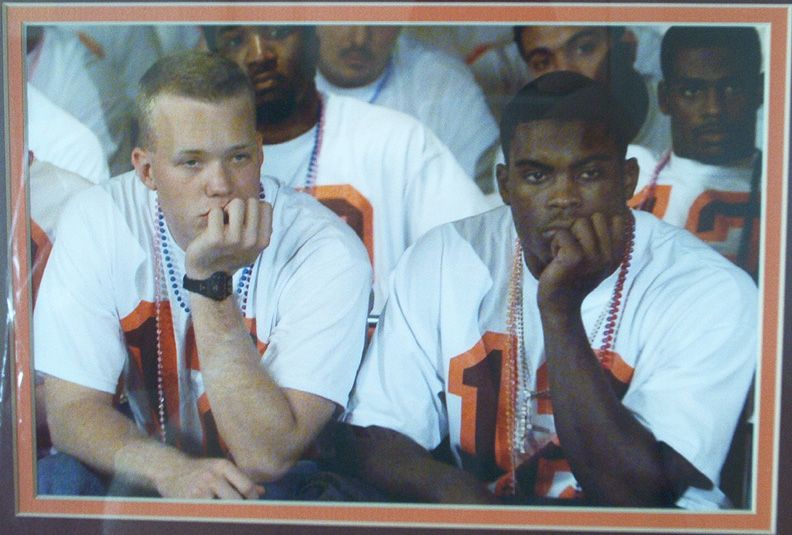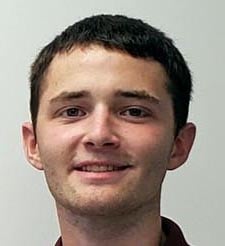
Special teams can often be the difference between winning or losing a game. It’s why former Virginia Tech head coach Frank Beamer put such a heavy emphasis on the third component of football, making “Beamerball” a hallmark of his coaching style.
In the same way, a pit stop in NASCAR frequently shapes the outcome of a race for a driver. Those several seconds where the pit crew jumps from behind the wall to refuel and change tires is NASCAR’s equivalent of a special teams play.
It’s part of the reason why former Virginia Tech holder Caleb Hurd (1996-1999) has never missed a beat in his 20-year career at NASCAR where he’s done everything from being the gasman on the pit crew, a general engineer, and now in his current role as a pit stop video coordinator.
“It’s kind of like kicking a field goal or holding a kick or snapping the kick, you get one shot at it and if you screw it up, you pretty much ruin the whole work of 30 to 40 minutes of what everybody else has been doing,” Hurd said of his time as a pit crew member. “You really shift the tide, so you have to be on your game. In that regard, my time here at Virginia Tech, and especially the big games we were able to play in, really gave me the right mentality to do what I needed to do on pit crew.”
Baseball was always the first love for Hurd and the main sport he focused on at Pulaski County High School. He played football simply because those Friday night lights in Southwest Virginia were more than just a game.
It was here where Hurd was the holder for Shayne Graham, the budding kicker who began getting recruited to big schools across the nation. The Hokies pursuit of Graham brought Hurd into the equation as he was offered a spot on the team by Todd Grantham to hold for Graham. Hurd was already planning on attending Virginia Tech to major in mechanical engineering, so it became an offer that he couldn’t turn down.
“[Grantham] said, ‘Well how would you feel about being an invited walk on if Shayne decides to come here?’ I was like, ‘Sure,’” Hurd said. “I was a Hokie fan growing up, so that was also really cool on my end. It was weird, but it was cool. I’m sure I’m the only recruited placeholder in history, ever.”
And so Graham committed to the Hokies as well, and Hurd became his sure-handed holder all four years in college. He quickly became a fan favorite, and a Heisman campaign was even launched, including a website that still exists today.
“I remember when Shayne and I first saw the sign, we thought it was either one of our apartment mates or friends or maybe even somebody from back home,” Hurd said. “When it turned out to be random students who thought it would be a really fun idea, that kind of blew me away a little bit. Honestly, all that silliness turned into I got to do an interview with Brent Musburger and all this other stuff that I would never get to do. I made the most of it.”

Hurd carries many memories from those days in Blacksburg with him, including the time he got his opportunity in another realm as the long snapper after Shane Beamer broke his finger against Rutgers in 1999. The Pulaski County native can also say he’s played for a National Championship, but the most memorable game is without a doubt the 1999 West Virginia game.
Like Shayne Graham has noted, Don Nehlen’s attempt to ice Graham’s 44-yard field goal backfired. It actually allowed Graham, Hurd, and the rest of the special teams unit to focus just a little more. Hurd also had another thought running through his mind.
“You get a little more of the jitters, your hands feel a little cold, all that good stuff,” Hurd said. “I just remember in the back of my mind, ‘If I drop this, I can’t leave here. I can never go back home.’ I had that in the back of my mind. Ultimately at the end, which also helped me with my NASCAR career, when it was time to go and when the whistle blew, you can actually push all that stuff out of your head and do what you’ve done a hundred times already. That’s the mentality you have to have and eventually I got back to that.”
The rest was history as Hurd corralled the snap, placed it with ease, and Graham’s kick sailed through the uprights. Unbeknownst to Hurd at the time, that wouldn’t be close to the biggest moment or biggest crowd he’d get to experience
A year later Hurd secured an internship with Hendrick Motorsports after he met fellow Virginia Tech graduate Brian Whitesell, Jeff Gordon’s team manager, on campus at Randolph Hall, and he was the recipient of a good word put in by Beamer. Hurd interned for the No. 24 team, and after graduating in 2001 following the fall semester, he came on full-time in a general engineering role.
Before Jimmie Johnson burst onto the scene, Hurd was a part of his pit crew for the earliest stages in his NASCAR career.
“That year [2001], we formed the No. 48 team with Jimmie Johnson out of scratch,” Hurd said. “They needed a pit crew and they had open tryouts, so Brian was like, ‘Man, you just got done with football. You’re in decent shape.’ It’s not quite the athletes it is today, so at the time I seemed like an athlete in that realm. They let me slide on as the catch can man, which was an assistant fueler type of position. I dipped my feet wet to get over the wall and learn how that all worked. I did that for Jimmie Johnson in his first three races.”
The following year Hurd moved back to Gordon and the No. 24 team where he spent the next 10 years. Along the way, Hurd found himself in the line of duty as the gasman for Gordon, one of the more dangerous jobs where he was equipped with a fire-retardant suit and a nearly 100-pound gas can to haul around and refuel in mere seconds.
“Luckily over 18 years I never actually caught on fire, so I was able to push that out of my mind because I never had to experience it,” Hurd said. “I was a little more concerned when I found out the can weighs about 100 pounds. The faster pit crews got, each can is approximately 12 gallons and the car holds more than that, so if you got to go over 12 gallons, you had to do a transition to get rid of one can, get another one, and get back in.”
Unlike the way roles are held now where guys are highly specialized in just one area, Hurd did this work with the pit crew on the weekends and worked in the shop where he put his mechanical engineering degree to use on the weekdays with a focus on data acquisition and sensors.
Hurd spent his final three years at Hendrick working on the pit crew for Dale Earnhardt Jr. before moving to Joe Gibbs, racing where he is today. He continued as the gasman for Denny Hamlin before stepping away from that role last year, and he now finds his place as the video coordinator for the pit crews of those with Gibbs Racing – Hamlin, Kyle Busch, Martin Truex Jr., and Eric Jones.
“I work with another engineer and we’re the metrics guys,” Hurd said. “A lot of our stuff is very metrics and data driven now. I’m in charge of camera views, and getting the footage back, and doing the breakdowns, and getting the numbers out so we can analyze each person on the pit crew.
“After I get all of the video and try to piece it all together and look at it, I have some analytics to look at so we can figure out how to get faster or what went wrong and what went right. That’s most of my early after the race work.”
NASCAR has thrusted itself into the spotlight as the first major sport to return with no fans in the U.S. since the COVID-19 outbreak. It’s created a unique opportunity for the sport to attract viewers who wouldn’t normally tune it. Hurd finds joy in being a part of it all as the drivers once again start their engines.
“There’s a lot of emotions,” Hurd said. “One, I’m glad to have a job to go back to and that we were able to stay afloat. Two, it’s been really weird to go back to work with a lot of new protocols, self-screening, wearing masks all the time, staying away from as big of groups when you can… NASCAR has done a good job of, ‘We’re the first one out there, so we’re not going to screw this up. We’re doing everything the right way.’”
Hurd has already experienced the thrill of a lifetime. He’s been on the crew with Daytona 500 winners, undergone the adrenaline rush of those 15-second-or-less pit stops, and lived out a dream in the process. Now 41 and living with his wife and two daughters in Huntersville, North Carolina, Hurd holds a deep appreciation for where it all started as a holder earned a special place in the hearts of Hokies.
“Coach Beamer had come down to speak to Hendrick Motorsports when I was there as a preseason speaker one year,” Hurd said. “Coach Foster has always been a huge NASCAR fan, so it’s been nice where I’ve been able to keep up with him a lot. Since I was so busy on the weekends, I got to come to a lot of Thursday night games there for a while before I became a parent. They were really cool in that regard, so it was nice to have that relationship long after I was done playing football. Not to mention I was this other special teams guy. All my teammates from back then who are on Facebook or whatever, that’s still been a family ever since.”





 Print
Print







Great story. Love these kind of what’s happening now with …… name your former player …… articles.
Great perspective. Thanks
Enjoyed the story. Very insightful. I did not realize that Hurd had left Hendrick Motorsports and moved to JGR. I am a Denny Hamlin fan, so Hurd’s association with Denny is an added bonus!
Enjoyed this very much. Thank you and look forward to more.
Trey Gresh (Blacksburg High) was another multi-year VT holder from the local area. I think that he was also a walk-on.
Love these stories & didn’t know he was now w/Joe Gibbs crew.
You Sir, are a gifted writer !!! You write many different stories really well !!! Thanks !!!!!!!
Great story. Thank you!
Very cool. Awesome content.
Great story about a great young man. Thanks Cory. Really enjoy “the where are they now” stories about former HOKIE athletes.
Terrific story, great and positive read, I needed that!!
Thanks for a fantastic story!